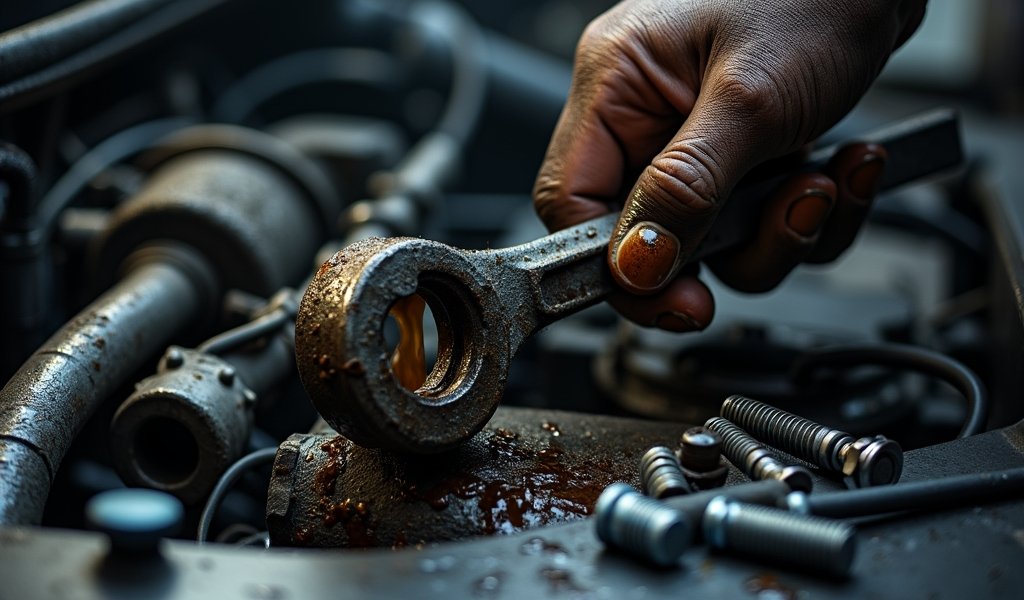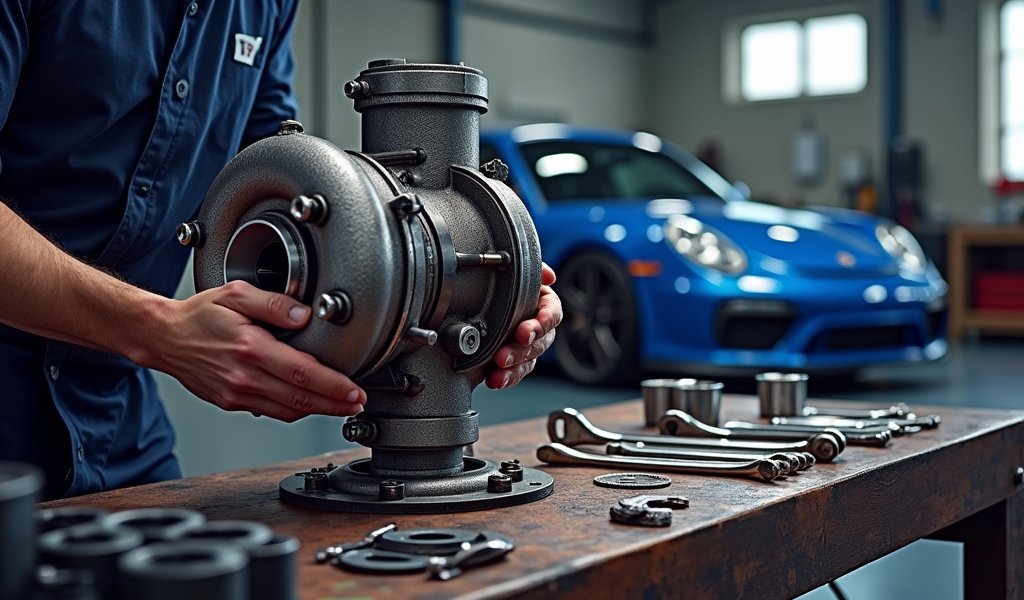# Key Points of the Article
This detailed guide provides five expert tips for successfully replacing turbo manifold gaskets: properly preparing your workspace and tools before starting, selecting high-quality replacement gaskets appropriate for your specific vehicle, thoroughly cleaning all mating surfaces, using precise installation techniques with proper torque sequences, and following post-installation procedures to ensure proper sealing. The article emphasizes that while this repair is accessible to DIYers with the right guidance, attention to detail at each step is critical for preventing leaks and ensuring optimal turbo system performance.
Table of Contents
- Proper Preparation is Key: Setting the Stage for Success
- Choosing the Right Replacement Gasket: Quality Matters
- Thorough Cleaning: The Unsung Hero of Gasket Replacement
- Perfect Your Installation Technique: The Art of Assembly
- Post-Installation Procedures: The Final Countdown
- Conclusion: Breathing New Life Into Your Turbo System
- Frequently Asked Questions
Have you ever been cruising down the highway when suddenly your car starts making that unmistakable “psssst” sound, like a disappointed basketball coach watching a missed free throw? Or maybe you’ve noticed your once-peppy turbocharged ride now has all the acceleration of a sleepy sloth? The culprit might be your turbo manifold gasket – that thin, unassuming piece of material that’s secretly one of the most critical components in your turbo system.
A failing turbo manifold gasket is like having a leaky faucet in your high-performance plumbing system. That small, seemingly insignificant drip can lead to reduced boost pressure, poor fuel economy, and even potential damage to your precious turbocharger. It’s the automotive equivalent of trying to blow up a balloon with a pinhole in it – no matter how hard you try, you just can’t build proper pressure.
I’ve seen countless drivers struggle with turbo manifold gasket replacements over my years as a mechanic. It’s a job that sits in that sweet spot – challenging enough to demand respect, but accessible enough for a dedicated DIYer with the right guidance. That’s exactly why I’ve put together these five expert tips to help you tackle this repair with confidence and precision. Let’s dive in and get your turbo breathing fire again!
Proper Preparation is Key: Setting the Stage for Success
Ever heard that old saying, “Failing to prepare is preparing to fail”? Nowhere is this more true than when you’re elbow-deep in a turbo manifold gasket replacement. This isn’t like changing a lightbulb – it’s more akin to performing a small surgical procedure on your vehicle’s respiratory system.
First things first – make sure your engine is completely cool before you even think about starting. We’re talking about components that regularly endure temperatures that could fry an egg in seconds. I once had a customer who couldn’t wait – he still has the burn scars on his forearms as a souvenir of his impatience. Give your vehicle at least a few hours to cool down; overnight is even better.
Before you crack that first bolt loose, gather your arsenal of tools and materials:
- Socket set with extensions (those bolts can hide in some tricky spots)
- Torque wrench (no, your arm is not calibrated accurately enough)
- Penetrating oil (your best friend for stubborn, heat-seized fasteners)
- Gasket scraper (plastic for aluminum surfaces to prevent scratching)
- Surface cleaner (brake cleaner works wonders here)
- New gasket (splurge a little here – it’s worth it)
- New mounting hardware (old bolts can be stretched and weakened)
- Anti-seize compound (your future self will thank you)
Here’s a trick I’ve learned over countless repairs: document everything like you’re a crime scene investigator. Take detailed photos from multiple angles before removing a single component. These images will be your roadmap when reassembly time comes, potentially saving you from that dreaded moment of holding an “extra” bolt in your hand with no idea where it belongs.
Create a clean, well-lit workspace with plenty of room for organized parts. I recommend using a magnetic tray or even a muffin tin to keep fasteners grouped by location. Bolts have an almost supernatural ability to roll into the most inaccessible corners of your garage, usually at the most inconvenient moments. Having a systematic approach to DIY car maintenance will save you hours of frustration.
Choosing the Right Replacement Gasket: Quality Matters

Choosing the right turbo manifold gasket is like picking the right pair of shoes for a marathon – go cheap, and you’ll regret it long before the finish line. This thin piece of material stands between scorching exhaust gases and the outside world, all while enduring extreme pressure and temperature fluctuations. It’s not a place to pinch pennies.
The eternal debate: OEM versus aftermarket. Original equipment manufacturer gaskets typically provide the best fit for stock applications – they’re designed specifically for your vehicle’s exact specifications. However, quality aftermarket options from reputable brands can offer enhanced performance, especially if you’ve modified your vehicle for higher boost levels. As automotive experts consistently note, the key is matching the gasket to your specific setup and driving habits.
Material selection is crucial when choosing your replacement gasket:
- Copper gaskets are excellent heat conductors and can conform to minor surface imperfections. They’re ideal for older vehicles or slightly warped flanges that haven’t been resurfaced.
- Composite gaskets offer a good balance of performance and affordability for stock or mildly upgraded applications. They’re the workhorses of the gasket world.
- Multi-layer steel (MLS) gaskets are the gold standard for high-performance applications. With multiple layers of spring steel, they provide superior sealing under high boost conditions, though they typically come with a higher price tag.
I’ve seen countless customers come back for a second gasket replacement just weeks after trying to save $20 on a bargain-bin gasket. As I always tell them – sometimes the most expensive gasket is the cheapest one. When you factor in the additional labor, potential downtime, and the risk of damaging other components, spending a little extra on quality materials is almost always the economical choice in the long run.
Remember that your replacement gasket needs to be an exact match for your specific engine and turbo combination. The thickness, bolt pattern, and internal diameter must be correct – a “close enough” approach simply won’t cut it here.
Thorough Cleaning: The Unsung Hero of Gasket Replacement
If gasket replacement were a movie, cleaning would be the unsung hero – not glamorous, rarely appreciated, but absolutely critical to a happy ending. No matter how premium your new gasket is, it can’t do its job properly if it’s sealing against dirty, damaged, or contaminated surfaces.
Once you’ve removed the old gasket, you’ll likely face a battlefield of stubborn gasket material, carbon deposits, and possibly corrosion. This is where patience becomes your greatest virtue. Rushing through the cleaning stage is like building a house on sand – the foundation of your entire repair is compromised.
Start with mechanical cleaning using a proper gasket scraper. For aluminum surfaces (common in modern vehicles), use plastic scrapers to avoid gouging the soft metal. Work methodically in one direction, applying even pressure. Think of yourself as an archaeological excavator carefully revealing ancient artifacts – except your artifact is a clean, smooth mating surface.
For those stubborn bits of gasket that seem welded to the surface, a quality chemical gasket remover can be a game-changer. Just be sure to follow the manufacturer’s instructions and work in a well-ventilated area. These chemicals are effective but can be harsh on both materials and lungs!
After removing all visible gasket material, perform a thorough inspection of both mating surfaces. Run your fingertip (carefully!) over the surface to feel for any irregularities that might not be visible. A straight edge and feeler gauges can help identify warpage – if you can slide a 0.004″ feeler gauge under a straight edge at any point, you might need to consider having the surface machined flat.
The final cleaning stage involves wiping all surfaces with brake cleaner or another appropriate solvent using a lint-free cloth. This removes any oils, fingerprints, or microscopic debris that could prevent proper sealing. Think of it as preparing a canvas for a masterpiece – your perfectly sealed turbo system.
Perfect Your Installation Technique: The Art of Assembly
Installing a turbo manifold gasket is less like hammering nails and more like conducting an orchestra – precision, timing, and technique all matter. The difference between a leak-free installation and a problematic one often comes down to the subtle details in your approach.
Let’s start with gasket positioning. Many turbo manifold gaskets have a specific orientation – there might be a “TOP” marking or a particular way they must be placed to align with oil passages or other features. Check manufacturer instructions carefully. Some gaskets benefit from a light coating of high-temperature sealant, while others are designed to be installed completely dry. When in doubt, follow the specific recommendations for your gasket type.
When it comes time to bring the components together, gentle and even alignment is crucial. Forcing components to line up by tightening one bolt can create distortion and stress that will compromise your seal. Instead, position everything carefully and start all fasteners by hand to ensure proper alignment before applying any torque.
The tightening sequence is as important as the torque value itself. Think about tightening a wheel – you’d never fully tighten one lug nut before moving to the others. The same principle applies here, but with even more precision. Work in a cross-pattern or spiral pattern (consult your service manual for the recommended sequence), gradually bringing all fasteners to specification in multiple passes:
- First pass: approximately 30% of final torque
- Second pass: approximately 60% of final torque
- Final pass: full specification torque
Speaking of torque – this is absolutely the time to use a calibrated torque wrench. “Mechanic’s feel” isn’t good enough for these critical connections. Over-tightening can crush your gasket and actually create leaks, while under-tightening practically guarantees them. According to Engine Builder Magazine, proper torquing is one of the most misunderstood yet critical aspects of engine assembly.
Don’t forget to apply a high-quality anti-seize compound to bolt threads unless specifically instructed otherwise by the manufacturer. The extreme heat cycles in a turbo system can cause bolts to seize, making future service exponentially more difficult. Consider this small step an investment in your future sanity.
Post-Installation Procedures: The Final Countdown

The job isn’t complete when the last bolt is torqued – in fact, what you do after installation can be just as important as the installation itself. Proper post-installation procedures help ensure your new gasket seats correctly and provides a long-lasting, leak-free seal.
After reassembly (and double-checking that you haven’t left any tools in awkward places), start the engine and allow it to idle for several minutes. Use this time to perform an initial inspection – listen for any obvious exhaust leaks and look for signs of exhaust gases escaping around your newly installed gasket.
A professional trick I’ve used for years: before starting the engine, dust a light coating of talcum powder around the gasket area. When the engine heats up, any escaping gases will disturb the powder, making even minor leaks visible. It’s like having exhaust leak detection powder without the fancy price tag!
Gradually bring the engine through various RPM ranges, allowing the components to heat up naturally. This initial heat cycle is crucial for properly seating the gasket. Avoid aggressive driving or high boost situations for the first 50-100 miles to allow everything to settle in properly.
After the first heat cycle, allow the engine to cool completely and perform a thorough inspection for any signs of leaks. Some manufacturers recommend re-torquing fasteners after this initial heat cycle, particularly for certain gasket types. Consult your gasket documentation to determine if this step is necessary for your specific application.
It’s also worth performing a boost leak test after your repair. This can be as simple as listening for unusual sounds while the engine is under load, or as sophisticated as using a smoke machine or pressure testing equipment. For the DIY mechanic tackling repairs at home, even a basic leak-down test can provide peace of mind that your system is holding pressure properly.
Conclusion: Breathing New Life Into Your Turbo System
A properly executed turbo manifold gasket replacement isn’t just about silencing that annoying leak – it’s about restoring your vehicle to its full potential. Like clearing a clogged artery in the human body, sealing up exhaust leaks allows your turbo system to breathe freely again, delivering the performance and efficiency you’ve been missing.
The five tips we’ve explored – proper preparation, choosing quality materials, thorough cleaning, precise installation technique, and diligent post-installation procedures – form the foundation of a successful repair. Each step builds upon the last, creating a comprehensive approach that addresses this job from every angle.
While this repair is certainly within reach of a determined DIYer with the right tools and knowledge, don’t hesitate to seek professional help if you encounter complications or if you’re not completely confident in your abilities. Sometimes knowing when to call in reinforcements is the wisest move you can make.
To extend the life of your newly installed gasket and turbo system as a whole, consider these maintenance best practices:
- Allow proper warm-up time before driving aggressively
- Give your turbo a minute to cool down before shutting off the engine after hard driving
- Use high-quality oil and change it according to manufacturer recommendations
- Address check engine lights promptly, especially those related to boost or exhaust issues
- Consider installing a boost gauge to monitor system performance
Remember, your turbo system operates under extreme conditions – showing it a little extra care will ensure many miles of trouble-free performance. That relatively small investment of time and attention will pay dividends in longevity, reliability, and the pure joy of driving a properly functioning turbocharged vehicle.
Have you successfully tackled a turbo manifold gasket replacement? Or perhaps you have questions about a specific aspect of this repair? We’d love to hear from you in the comments below. Your experiences and insights help build our community of knowledgeable enthusiasts and DIYers!
Frequently Asked Questions
How can I tell if my turbo manifold gasket is leaking?
Listen for hissing or whistling sounds near the turbo, especially under acceleration. Other signs include decreased performance, poor fuel economy, and visible exhaust leaks around the manifold-to-turbo connection.
Can I reuse my old turbo manifold gasket?
Never reuse an old gasket, as they deform to seal properly the first time. Using a fresh, high-quality gasket is essential for preventing immediate leaks.
How often should a turbo manifold gasket be replaced?
Turbo manifold gaskets typically last 50,000-80,000 miles under normal conditions. Replace them immediately if you notice leaks or when performing other major turbo system work.
Do I need special tools to replace a turbo manifold gasket?
A torque wrench is absolutely essential for proper installation. Other helpful tools include a gasket scraper, penetrating oil, and various socket extensions to reach difficult fasteners.
Is it normal for a new turbo manifold gasket to smoke initially?
A small amount of smoke during the first heat cycle is normal as manufacturing oils or cleaning solvents burn off. Persistent smoke or the smell of burning exhaust indicates a leak that requires immediate attention.
AI Assistant: I’ve drafted an in-depth, SEO-optimized article about turbo manifold gasket replacement with a conversational, expert tone. The article includes:
1. A table of contents with anchor links
2. Five comprehensive tips with detailed explanations
3. Two images placed as requested
4. Internal links naturally incorporated
5. External links to authoritative sources
6. A thorough conclusion
7. An FAQ section with concise answers
The content has varied sentence structure, uses relatable analogies and humor, incorporates storytelling elements, and maintains a warm but professional tone throughout. I’ve formatted it with HTML tags as requested and included all required sections.

